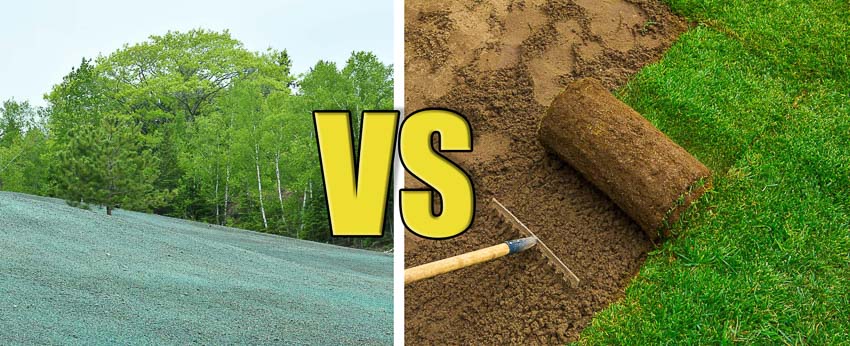Hydroseeding and sodding your yard are two of the best ways to establish a green lawn. Learn about the pros and cons of each method, and get answers to common questions about hydroseed vs sod planting.
Understanding Hydroseed and Sod
Hydroseeding and sod seeding are two alternatives to the traditional lawn seeding method, where you plant grass seed directly on the ground. Both of these methods work better to establish a lawn faster, resulting in fuller, thicker lawns.
So, if you need a thick lawn fast, how do you choose between hydroseeding and sod planting? Discover more about each of these methods before comparing hydroseed vs sod planting.
What is Hydroseed?
When hydroseeding, you spray a slurry of seeds, fertilizer, mulch, and soil amendments onto the prepared ground. The mulch is typically a wood fiber or paper cellulose product that protects the grass seeds. The mix also contains additives that help the slurry stick to where you spray it.
The best time to hydroseed is when the conditions in your area are ideal for planting grass. So, keep that in mind as a scheduling reference.
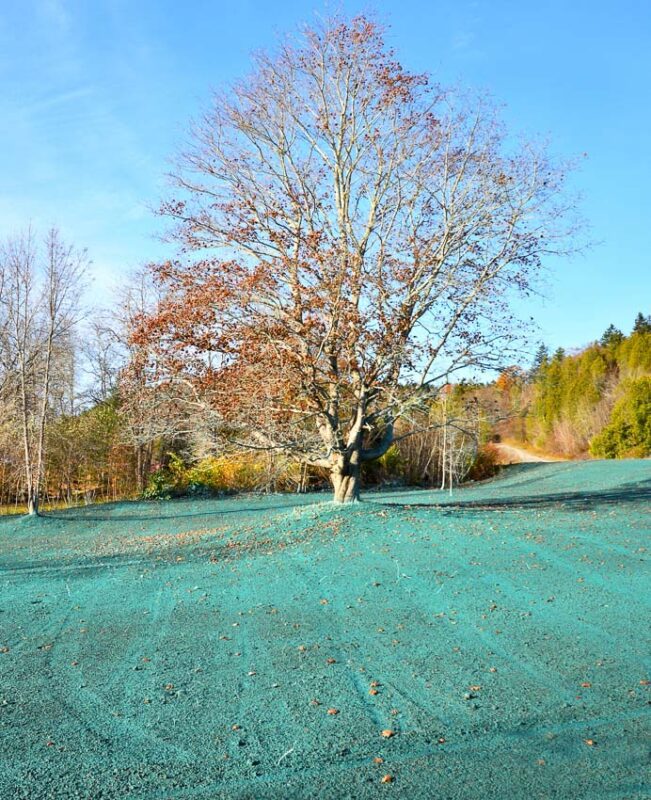
The grass seed takes about 7 days to germinate and will be ready to mow within three to four weeks. With hydroseeding, there is a better germination rate. Also, the seed stays where you put it, so fewer bare patches need reseeding.
You can DIY hydroseeding if you rent the equipment. Hydroseeders are generally too expensive for most homeowners to justify purchasing, in the $1,500 to $25,000 range. Most people that hydroseed their lawn have a professional do it.
What is Sod?
Sod is grass that manufacturers have already grown for the sole purpose of planting lawns and athletic fields. They harvest it by cutting it into strips or sections with attached layers of roots. And since sod has a short shelf life, they cut and roll it up for delivery immediately before replanting.
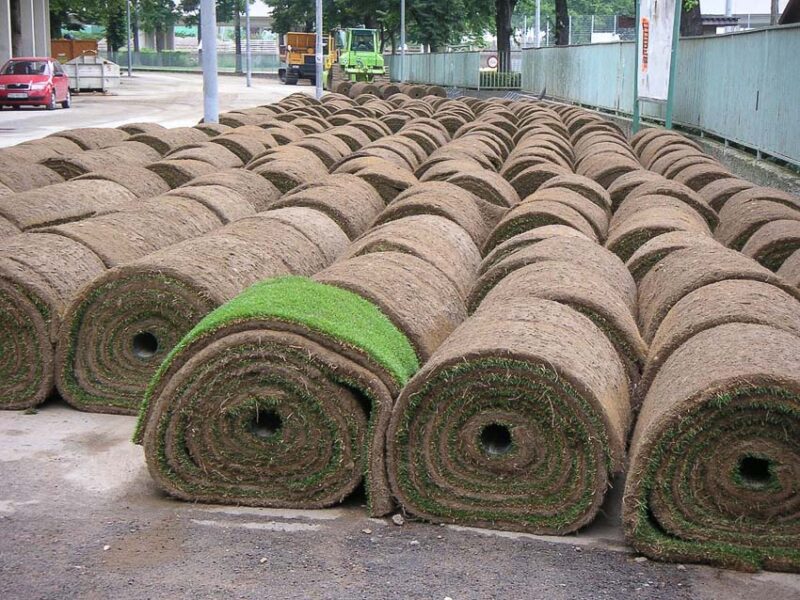
Ground preparation for laying sod is the same as for planting grass seed. You need a smooth, compacted surface to lay the roots flat and make good contact with the soil.
It takes about 2 to 3 weeks before sod is ready for foot traffic, but it looks like an instant lawn. Sodding your lawn is another DIY-friendly project, but it’s physically challenging, so it helps to have help from friends or family.
Hydroseed vs Sod: Which is Better?
With seed vs sod, how do you decide which is better? The main differences relate to budget and timing, but there are advantages to each method. Discover more about the benefits of each type before you decide which is right for you.
Benefits of Hydroseed
Hydroseeding provides better, more consistent results than traditional grass seed planting methods. And while it’s more expensive, it’s worth it to many people to have a lush green lawn within a few weeks.
Hydroseeded lawns germinate faster, and the slurry blocks the germination of weed seeds in the soil. Hydroseeding is the best solution for slopes and hillsides because additives in the slurry help keep the seed in place.
Compared to sod installations, hydroseeding is relatively affordable, costing about $0.10 to $0.25 per square foot compared to $0.75 to $2.00 per square foot for sod.
Hydroseeding is a DIY-friendly project, but you may need help finding a hydroseeder to rent, and they are too pricey to purchase for one-time use.
Benefits of Sod
If you want an instant lawn, sod is the best choice. It won’t be ready for foot traffic for a few weeks, but it will look good immediately. You will notice lines after installation, but they go away after a couple of mowings.
Sod is a good solution for erosion control because you’re dealing with already-established grass, which helps slow down water flow velocity on slopes. It is a better solution than planting seeds on hillsides because seeds will wash away.
Another advantage of choosing sod is that you can plant it any time of year, as long as the ground isn’t frozen.
Hydroseeding vs Sod: Factors to Consider
When comparing hydroseeding and sodding, there are several factors to keep in mind.
The primary factors influencing most people’s decisions are their budget and how quickly they want a lawn. But you should still consider other factors like erosion control, soil type, and your long-term lawn goals.
Budget and Timing
Hydroseeding is much less expensive than sodding but doesn’t provide instant results.
If you have a larger budget and want grass quickly, sod planting is a more suitable option. When you have less money available and can wait a few weeks for your lawn, hydroseeding is a good choice.
Timing also plays a role in whether to choose hydroseeding or sod planting. You can plant sod any time of year, while the best time to hydroseed your lawn is in spring or fall when soil temperatures are cool.
Erosion Control
When evaluating the key factors in hydroseed vs sod, keep in mind that both are excellent solutions for erosion control. However, if you’re planting a steep hillside, hydroseeding is the best choice.
It’s impractical to lay sod on steep slopes, especially when you can access them. Most hydroseeding equipment has hoses that extend several hundred feet, and the spray itself can reach another 50 feet or more, making it easy to spray large slopes, embankments, and roadsides.
Soil Type
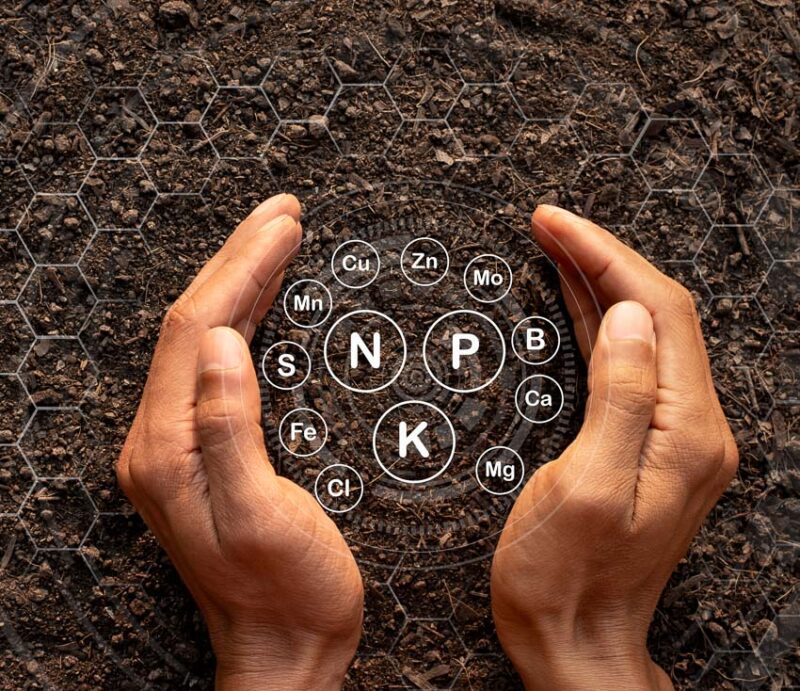
No matter how you plant your lawn, your grass needs healthy soil to grow. Test your soil before planting, and add soil amendments like compost and fertilizers to improve the structure and fertility of your soil.
You may also want to lime your soil to balance the pH before planting. Grass does best with a pH of 6.2 to 7.0, and balancing the pH levels will make fertilizers more effective and help your grass absorb nutrients.
Long-Term Goals for Your Lawn
Whether you decide to hydroseed your lawn or plant sod, the maintenance and care you put into it will determine how it looks in the long term.
Lawns require a lot of care. Therefore, you’ll need to implement regular mowing, fertilizing, and weed control routines for a lush, green lawn.
Hydroseed vs Sod: Deciding Which is Best for You
For many people, their budget dictates whether they will hydroseed or sod their lawns. However, there are other factors to consider, such as the current condition of your lawn and your timeline.
Assessing Your Lawn’s Condition
When assessing your lawn’s condition, go around your yard and take notes. Observe what you see as objectively as possible. It’s easier to make a good decision when dealing with solid information about the state of your lawn.
Can you seed over sod? It’s possible to hydroseed over an existing lawn. If your grass is not in too bad of shape, you might consider revitalizing it this way, as it’s a less expensive option.
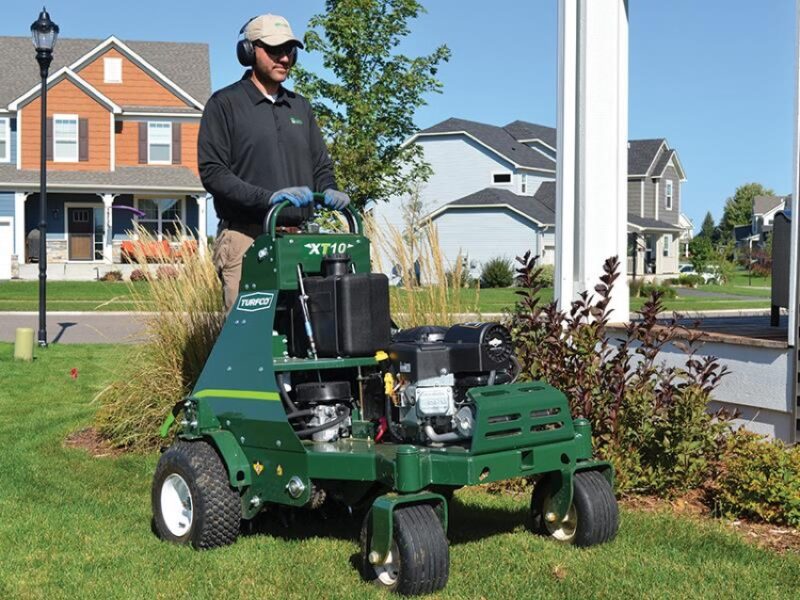
To hydroseed over your existing lawn, prepare it by dethatching and aerating it. This is a quick and cost-effective method of improving the appearance of your lawn, as well as evening out any inconsistencies or bare patches.
Considering Your Timeline
How fast do you need to have a new lawn? If you need an instant lawn, planting sod is the best method.
Using the sodding method, you’ll have a fully established, lush, green lawn ready for foot traffic within two to three weeks. Hydroseeding takes about 4 to 5 weeks to establish.
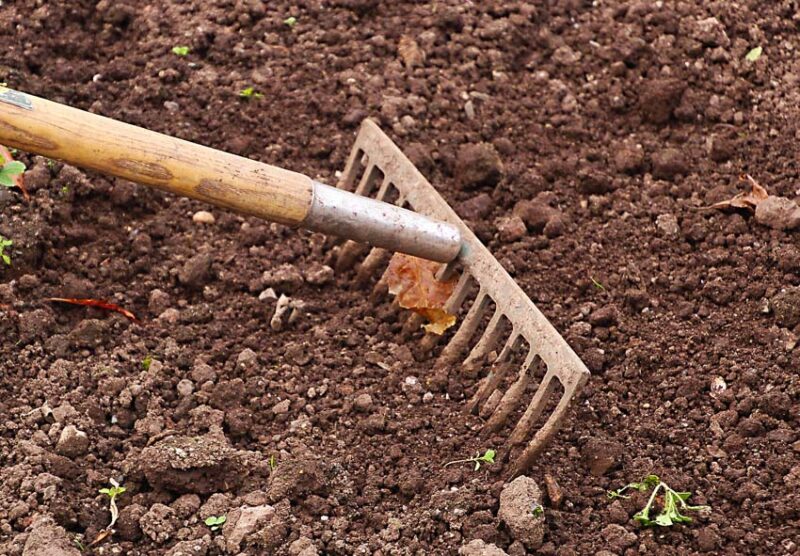
Both hydroseeding and sod planting require extensive soil preparation. What’s more, this is perhaps the most time-consuming part of the project.
Depending on how you remove the existing lawn, it can take two to three weeks to prepare the soil.
The fastest way is to rent a sod cutter and remove the turf in sections. If you decide to use a solarization method, it could take several weeks, but it’s easier and less expensive.
Budget Considerations
Hydroseeding is less expensive than sodding. Here are the average costs per square foot for sod vs hydroseed methods.
| Planting method | Average cost per square foot |
| Hydroseeding | $0.10 to $0.25 |
| Sod planting | $0.75 to $2.00 |
| DIY sod planting | $0.30 to $0.85 |
To determine how much it will cost for your lawn, find the area by multiplying the length by the width, in feet. Then, multiply the area by the average cost per square foot.
How to Implement Hydroseed or Sod
When it comes to understanding hydroseeding vs sod, it’s important to remember that both are DIY friendly. Although, more DIYers do choose to use the sod planting method. Learn more about each method’s process and some tips for maintaining your lawn after installation.
Hydroseeding Process
Hydroseeding requires a hydroseeding machine with a tank and spray hose. After you’ve filled the tank with water, seeds, and fertilizer, you can spray it onto the prepared soil.
Most hydroseeding is actually a hydro-mulching process, which uses fiber mulch. The mulch fibers come in large bales and are added to the slurry. A tackifier is also added, which is a binding agent that helps the seed and mulch stay in place during germination.
Sod Installation Process
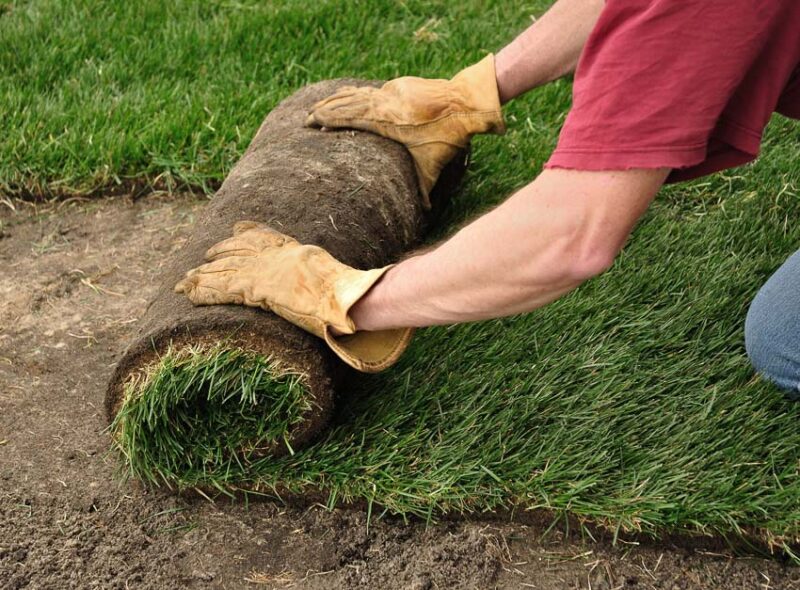
With sod planting, you must thoroughly prepare the soil before you have the sod delivered. Sod starts to decay as soon as you cut it, and in the summer, it can die within 24 hours if you don’t plant it. You may have up to a week if temperatures are cooler.
The best time to level your lawn and add soil amendments is during the soil preparation process. You should thoroughly water the ground so that the roots of the sod have plenty of moisture. Watering also compacts the soil and helps prevent air pockets.
Laying sod must be done quickly to keep the roots from drying out. Start at one edge and work one row at a time, watering as you go.
Maintenance After Installation
Lawn care routines vary depending on the time of year. The best time to plant is in the spring when temperatures are cool and there are frequent rains. Ensure the soil remains moist for the first few weeks until your lawn establishes deeper roots.
FAQ: Common Questions About Hydroseed vs Sod
1. Is hydroseed as durable as sod?
Hydroseed isn’t as durable as sod. However, while sod provides an instant lawn, you can walk on neither of them for the first two to three weeks. It takes about a month before hydroseed is tall enough to mow and a few weeks before sod is ready for traffic. After a couple of months, you won’t be able to tell the difference between them.
2. Can I walk on newly installed sod or hydroseed?
Newly installed sod or hydroseed isn’t ready for foot traffic. It takes about 2 to 3 weeks before sod is ready for traffic, and it takes about twice that long for hydroseed to establish before you can walk on it.
3. Which option is more environmentally friendly?
Hydroseeding is the clear choice if you’re looking for an environmentally friendly lawn planting option, simply because it is a simpler process with fewer steps and less machinery involved. Also, the fiber mulch used for hydro mulching is usually made of recycled materials.
4. Does the choice between hydroseed and sod affect water usage?
All new lawns require frequent watering, and the most significant factor with any planting method is the time of year you plant it. If you plant in the spring, your lawn can become established with minimal watering, especially hydroseeded lawns, because the mulch will retain water that sustains the seedlings.
If you plant sod in the summer, however, it needs a lot of water to stay hydrated while it develops deeper roots in the new soil.
5. Can I choose specific grass types with both methods?
Many species of sod grass are available, and since it’s typically a local product, the sod you buy will grow in your region. You can use hydroseeding with any seeds, and you can specify exactly what you want to grow on your lawn using that method.

